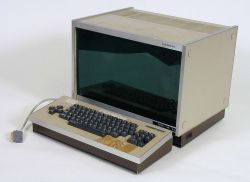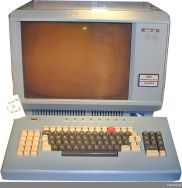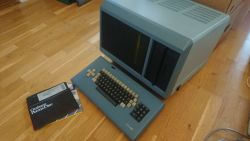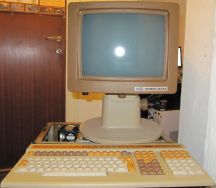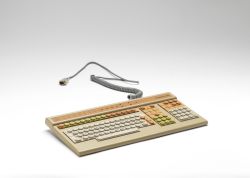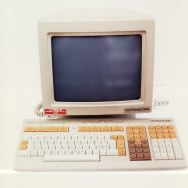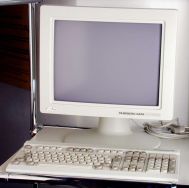Tandberg
| File:Tandberg logo.svg | |
| Former type | Public limited company (Aksjeselskap) |
|---|---|
| Industry | Consumer electronics, computer hardware |
| Fate | Several splits, eventually dissolved |
| Founded | 1933, 1979, 1991 |
| Founder(s) | Vebjørn Tandberg |
| Defunct | 1996 (brand lives on) |
| Headquarters | Oslo, Norway |
| Website | http://www.tandberg-display.no/ |
Here we only consider the division of Tandberg that used to produce computer terminals, minicomputers, monitors, and keyboards.
History[edit | edit source]
As the original name Tandbergs Radiofabrikk suggests, the company founded by Vebjørn Tandberg began as a producer of radio receivers. Through the early 50s they also got into reel-to-reel tape machines for audio, complementing their radio-sets, and by the late 1960s they were also making instrumental reel-to-reel tape recorders (like the Tandberg series 100). It was then decided to create a dedicated data division in 1970, around the time Norsk Data was getting established in the mini-computer business. Besides their data recording products, for which Tandberg remains well-known till these days, this division also started the development of display technology. In 1974, their first video display terminal, TDV 2000, was presented -- the series number presumably chosen owing to the futuristic connotation it had at that time. It already sported a detached keyboard.
When in 1977 the succeeding TDV 2100 series of terminals and microcomputers was introduced, Siemens became interested and closed a 5-year OEM agreement with Tandberg in early 1978. Tandberg became the main computer monitor and terminal maker for the Siemens data products division. Nevertheless the mother company, Tandberg Radiofrabrikk, had to file bankruptcy in December 1978 after major echonomic downturn combined with fierce competition from the emerging market of cheap imported radio-receivers mass-produced in Asia. Months before the bankrupcy, shareholders forced founder Vedbjørn Tandberg out of the company, leading to his unfortunate suicide. At the height in 1976, the company had 3500 employees, and when the bankrupcy was inevitable in 1978 the Norwegian government got involved due to the sheer amount of assets in the liquidation. Siemens was naturally heavily involved in the bancrupcy negotiations too, and as a result the former data division emerged from the ashes as Tandberg Data in 1979. Siemens holding 51% of the shares, the rest was owned by the state of Norway. The remainder of Tandberg Radiofrabrikk dropped the mass-market radio receivers, being further split into two. The Tandberg Television portion would become a standalone company until aquired by Ericsson in 2007, while the remaining portion started specializing in more niche audio-video and eventually modem markets as just Tandberg. It was also agreed that the new Tandberg company would be run as a subsidiary of Tandberg Data, and in the end ended up as a maker of telepresence devices and was absorbed by Cisco in 2009. Cisco still own the plain Tandberg brand.
In the late 1970s ergonomics started to become relevant and in this respect Scandinavia was about 5 years ahead of the rest of the world: Norwegian legislation already imposed corresponding requirements as early as 1980. The terminal line TDV 2200 introduced in 1980 was constructed to surpass these and won Tandberg several design awards as well as lasting fame for ergonomics and build quality.
In the course of the merger of its data products division with Nixdorf in 1990, Siemens sold almost all of its Tandberg Data shares. In the following year, Tandberg Data spun off its terminal business into Tandberg Data Display, creating the Tandberg Display brand. The brand survived when Tandberg Data Display eventually was reduced to sales and marketing in 1996, sold to new Swedish owners, and renamed to Ergonomic Office Systems. In 2000 they became part of MultiQ. The storage division of Tandberg Data had a different fate and survived, merged with Overland Storage, as a daughter of Sphere 3D Corp.
Among keyboard enhusiasts of today, the Tandberg brand name is mostly associated with the batches of TDV 5010 keyboards that appeared at eBay around 2010. These were built in 1998 by Cherry for the owners of the brand, copying the look and feel of the Tandberg original and its Siemens keycaps of the 1980s – at a time when the Tandberg Data Display company already was history.
Products[edit | edit source]
| Series | Type | Generation |
|---|---|---|
| TDV 1200 | 14" monochrome terminals | 1980s, late |
| TDV 1400 | 14" colour terminals | 1980s, late |
| TDV 2000 | 1st generation of terminals | 1970s, mid |
| TDV 2100 | 2nd generation of terminals, microcomputers | 1976 to 1982 ca. |
| TDV 2200 | 15" monochrome terminals | 1980 to mid 1980s |
| TDV 2300 | "Video computer", Tandberg OS or CP/M | 1982 to mid 1980s |
| TDV 2400 | Intelligent terminals, "Topaz" microcomputers | 1980s, late |
| TDV 2500 | "Topaz" Motorola microcomputers | 1980s, late |
| TDV 3100 | IBM compatible mainframe terminals | 1980s, mid |
| TDV 3200 | IBM compatible mainframe terminals | 1980s, mid |
| TDV 5000 | PS/2 keyboards | 1989 to late 1990s |
| TDV 5200 | PC terminal conversion kits | 1990s, early |
| TDV 5300 | PC monitors | 1980s, starting late |
| TDV 5700 | Windows drivers | 1990s, early |
| TDV 6200 | X grayscale terminals | 1990s, early |
| TDV 6300 | X colour terminals | 1990s, early |
| TDV 6700 | Unix drivers, X server | 1990s, early |
The early keyboards were at first high-profile reed switches from C.P. Clare Int., but foam-and-foil versions based on Key Tronic switches were eventually also available. Later OEM products for Siemens (like the TDV 2114-based System 6.610 or the 3974 terminal) received RAFI RS 76 M switches. From the introduction of the TDV 2200 series in 1980 on, all new products manufactured by Tandberg Data exclusively had Siemens STB switches in their keyboards. After own production was stopped and only the brand survived, keyboard production was commissioned to Cherry and changed to ML switches.
Gallery[edit | edit source]
-
TDV 2000 terminal
Photo: Norsk Teknisk Museum -
TDV-2114 "Intelligent Terminal" computer
-
TDV 2215 keyboard
Photo: Norsk Teknisk Museum -
TDV 6230 terminal, with keyboard
Photo: Norsk Teknisk Museum
